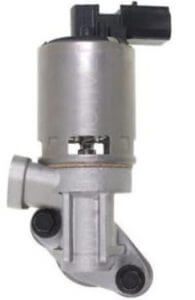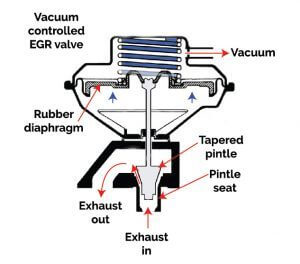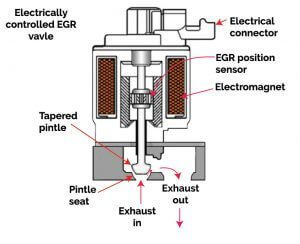When to replace an EGR valve
What does an EGR valve do and what goes bad?
An exhaust gas re-circulation EGR valve reduces pollution by sending a portion of the exhaust gasses back into the engine when the car is cruising at higher speeds. Engines need less fuel when they’re cruising. Since the engine cylinder is a fixed size, it must be filled with either a full dose of air and fuel, or a partial dose of air and fuel and the remainder with something that fills the space but doesn’t burn. Exhaust gas is the perfect substance to add because it’s inert. In addition to saving fuel when cruising, the addition of exhaust gas and lower dose of air/fuel helps to reduce combustion temperatures. High combustion temperatures cause the Nitrogen in the air to combine with oxygen to form Oxides of Nitrogen, a major component of smog. So the EGR valve is a critical component of your car’s emission system to reduce smog and lower combustion temperature.
How does the valve work?
EGR valves come in two styles; vacuum controlled or electrically controlled. In older cars, engine vacuum is used to move a rubber diaphragm that lifts or releases the flow regulating pintle. Vacuum controlled valves don’t have a position sensor to monitor how much the pintle actually opened or closed compared to how much the engine computer wanted it to open or close. When car makers converted over to electrically operated EGR valves, they installed position sensors to get feedback as to actual versus commanded position. Here are diagrams of both styles.
How does an EGR valve fail?
Vacuum operated valves can develop leaks in the rubber diaphragm that raises and lowers the pintle. That can cause the symptoms listed below. On newer cars, the electrically controlled EGR valve can develop a short or open in the electromagnet or a failure in the position sensor. Both types of valves are susceptible to carbon buildup from the soot in the engine’s exhaust. When buildup occurs on the seat, the pintle can’t close all the way. That allows exhaust gas to flow into the engine at all times, chocking the engine at lower speeds. Some engines are prone to carbon buildup in the passages leading up to the EGR valve. When that happens, the EGR valve opens, but no exhaust flows because the passage is completely plugged, just like a clogged drain in your home. The only way to remove the clog is to run a drill or snake down the passage and vacuum out the crusty carbon.
On older cars operated by engine vacuum, the EGR valve diaphragm can deteriorate and leak, causing a rough idle and a check engine light. In that case, the valve should be replaced. Also, over time the valve can accumulate carbon buildup and stick open, causing a rough running engine. Or, the EGR position sensor can fail, causing a check engine light. If your car is running fine at idle and you don’t have a check engine light, there’s no need to replace or clean an EGR valve.
Some shops recommend periodic cleaning. I think that’s a waste of money. If the valve is stuck open due to carbon, rather than the money to clean it, you’re better off having the shop install a new EGR valve.
Symptoms of a bad EGR valve
• Rough idle—Carbon buildup on the tapered seat prevent the pintle from seating allowing exhaust gas to flow into the engine at idle and choke it, leading to a very rough idle.
• Poor performance at low speeds—EGR flow should only occur at cruising speeds and light load. If the valve is sticking open due to carbon buildup, the exhaust flow reduces the amount of fuel added to the cylinder and results in poor performance and lower MPG.
• Stumble during acceleration—More common on older vehicles with a vacuum operated EGR valve and a leaking diaphragm. The vacuum leak dilutes the gas mixture causing a lean condition that feels like the engine is starved for fuel.
• Knocking sound—This occurs when an EGR valve doesn’t open at all or the exhaust passages are totally clogged. Without EGR flow, the combustion chamber runs hot causing the fuel to ignite before the spark plug fires. The early ignition causes the piston to push backwards against the crankshaft while it still pushing the piston up. The sound you hear is metal crashing against metal. If left unattended, that knock can destroy your engine.
• Check engine light is on—When an EGR valve fails, the computer turns on the check engine light and sets a trouble code in the computer’s memory.
How to fix an EGR valve trouble code
If your check engine light is on and the shop discovers an EGR related trouble  code stored in the computer, some shops try cleaning the EGR valve. Unfortunately they have to remove the valve to do that. You may think you’re saving money by replacing the valve itself. But you often wind up paying more due to the labor to clean the valve. In most cases, it’s cheaper over the long run to remove and replace the valve.
code stored in the computer, some shops try cleaning the EGR valve. Unfortunately they have to remove the valve to do that. You may think you’re saving money by replacing the valve itself. But you often wind up paying more due to the labor to clean the valve. In most cases, it’s cheaper over the long run to remove and replace the valve.
With the valve off, the shop should also check to see that the passages from the exhaust to the valve are full open. If not, the shop must clean the carbon buildup out of the passage.
©, 2016 Rick Muscoplat
Posted on by Rick Muscoplat


